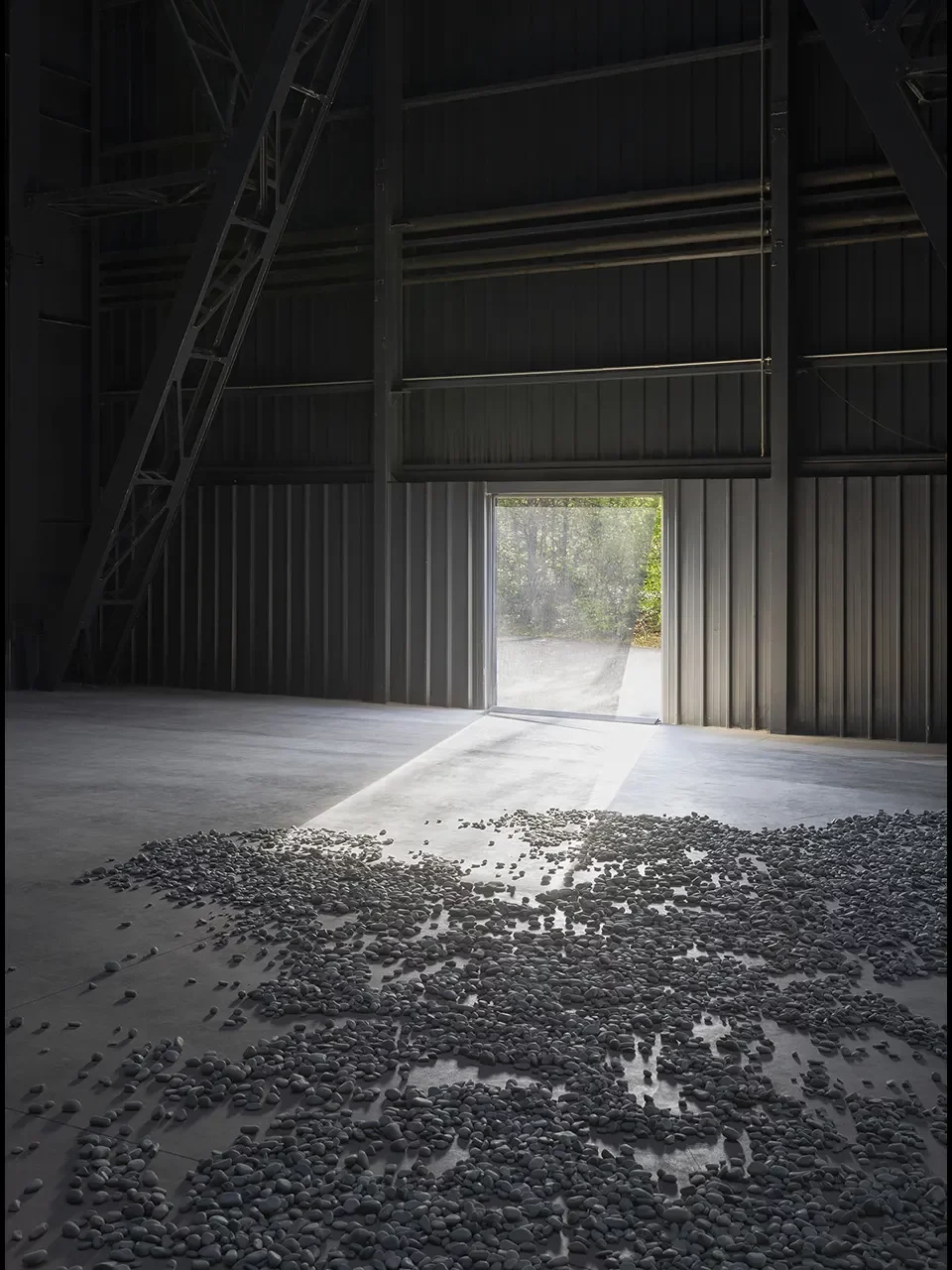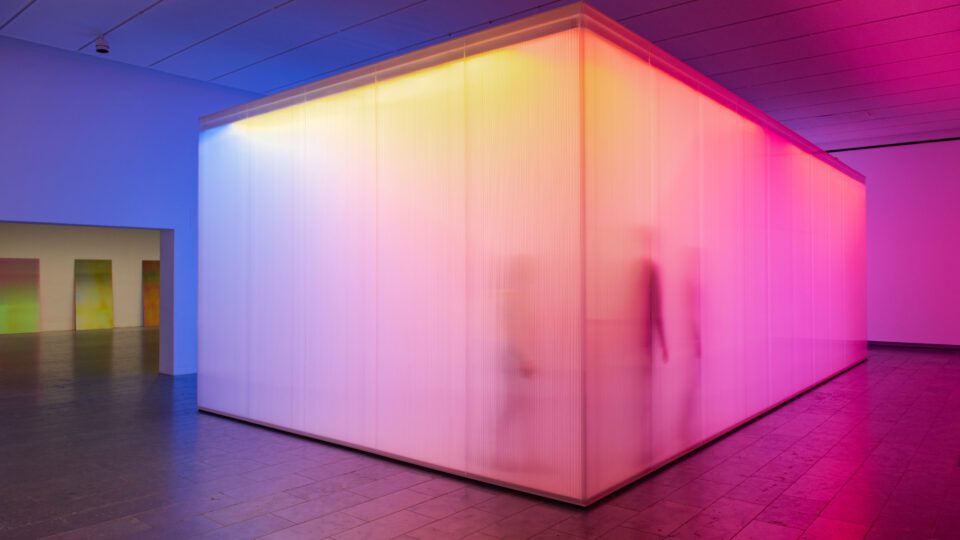The bare-brick building of Pirelli HangarBicocca was once the site for the global tyre manufacturer. The factory opened in 1903 and saw the construction of trains and railway carriages, followed by aeroplanes and equipment for WWI. By the 1980s, the industrial area was decommissioned, falling into neglect over the next two decades. In 2004, however, the complex was converted into gallery space and has since exhibited conceptual artists Cildo Meireles (2015), Sheela Gowda (2019) and Anicka Yi (2022).
This Spring, Belgian artist Ann Veronica Janssens’ (b. 1956) latest retrospective occupies the industrial complex in a display spanning four decades of the artist’s career. Grand Bal, curated by Roberta Tenconi, charters the collision of art and architecture, testing the boundaries between absence and presence. Translating into “great ball”, the exhibition plays with movement, direction and light in a series of rooms lit by both artificial fog and natural sunlight. Ephemeral sculpture and installations are set alongside rough concrete floors and high ceilings, contributing to a world that according to Tenconi “centers not so much on objects as on visitors.” The result is an altered, dreamlike reality, staged in a historic, concrete environment.


In Drops, 12 mirrors are spread out on the gallery floor, reflecting the double-pitched roof and scaffolding bars of the building. Isometric patterns and squares of white light are captured in large circles akin to rain droplets. Viewers are offered new dimensions of seeing and experiencing space. In waves (2023), for example, Janssens converts fire doors into porous nets. A transparent PVC film replaces the exit openings, where from afar, a thin gauzy mesh is observed. On closer inspection however, the material appears more complex. Outdoor light illuminates shadows of plastic, creating a swirling, contoured pattern suggestive of the curving sculptures of Henry Moore and Barbara Hepworth. Layers of mesh ripple in the air, striking an iridescent effect and creating a sensation similar to the rolling motion of the sea.


These works respond to physical space and individual touch. At the centre of the gallery, three swings dangle from the ceiling, each containing a heat-reactive material that changes colour on contact with the body. Visitors are invited to engage and sit with the devices, mobilising a kinetic experience that symbolises a fleeting moment of connection. Beneath this, identical grey bricks contribute to what the artist defines as “super spaces.” The existing architecture of the Pirelli building is extended in Area (2023), reminiscent of the linear artworks of Donald Judd. Judd, a pioneer of minimalism (although famously rejecting the term) is known for his “stacks” of galvanised iron, creating grid-format sculptures characterised by clarity and sparsity. In his 1965 essay Specific Objects, the artist explores the emergence of “new art”, writing, “It isn’t necessary for a work to have a lot of things to look at, to compare, to analyze one by one, to contemplate.” This sense of collective responsibility, emphasising the importance of a whole ensemble over individual parts, is shared today by Janssens. Notions of hierarchy and conformity are challenged through works that extend beyond visual objects. Public assembly and interaction is encouraged – audiences must constantly be in relation and in contact with works in order to complete them. In an interview with Studio International (2020), the artist explains “Movement has always been very important, along with the idea that it’s the audience themselves who make the work.”

In the exhibition’s closing work, viewers move from the “Navate” section of the complex into the “Cubo”, a cubic barrel-vaulted building. The gallery is filled with artificial mist in an installation that according to a senior curator at The Espai d’Art Contemporani de Castelló (EACC), “abolishes all obstacles” and “materiality”, as if a palate cleanser at the end of the show. Janssens revisits her “mist sculptures”, reworking pieces such as yellowbluepin (2015), originally made for London’s Wellcome Collection. Multi-coloured fog forces navigation akin to walking through a sunset, or as the artist explains to Galerie Micheline Szwajcer “in a slow-motion film with almost no images.” Neon rooms evoke the immersive “skyspaces” of James Turrell, fluorescent rooms of Liz West and rainbow panoramas of Olafur Eliasson, the latter reviewed as “an instrument that tunes you – so that your body is transformed into a colour resonator” (Architecture Daily, 2011). The 2023 version of the MUHKA, Anvers installation departs from a warm spectral palette, instead using a ghostly white vapour reminiscent of the artist’s Horror Vacui from the 1999 Venice Biennale. The version presented in Milan refers to the first staging of the work in Antwerp in 1997, prior to the addition of artificial pigmented lights. Devoid of colour, all senses of surface and depth are removed entirely, allowing viewers to reflect on their sensory environment, as if to see themselves seeing.
Perception is heightened in Grand Bal. A powerful visual language is carved out in the retrospective, where, as Benoit Loiseau writes in Wallpaper (2023), mist and light are like “stone and marble: raw materials to be sculpted and perfected.” Site-specific works challenge the boundaries of architecture, where time appears to be suspended. Janssens reimagines Pirelli’s industrial roots, creating a world of mobility, invention and play.
Grand Bal
Pirelli HangarBicocca | Until 30 July
Words: Chloe Elliott
Credits:
1. Blue, Red and Yellow, 2001 – Open date Installation view, Louisiana Museum of Modern Art, Humlebæk, 2020. Courtesy the artist and Louisiana Museum of Modern Art © 2023 Ann Veronica Janssens / SIAE Photo © Kim Hansen
2. waves, 2023. © 2023 Ann Veronica Janssens / SIAE. Photo Andrea Rossetti
3. Drops, 2023. © 2023 Ann Veronica Janssens / SIAE. Photo Andrea Rossetti
4. MUHKA, Anvers, 1997-2023. © 2023 Ann Veronica Janssens / SIAE. Photo Andrea Rossetti
5. Ann Veronica Janssens for PHB, 2004-23 Installation view at Pirelli HangarBicocca, Milan, 2023 © 2023 Ann Veronica Janssens / SIAE Photo Andrea Rossetti
5. Blue, red and yellow, 2001. Courtesy the artist and EACC Castelon © 2023 Ann Veronica Janssens / SIAE Photo © Pascual Mercé





